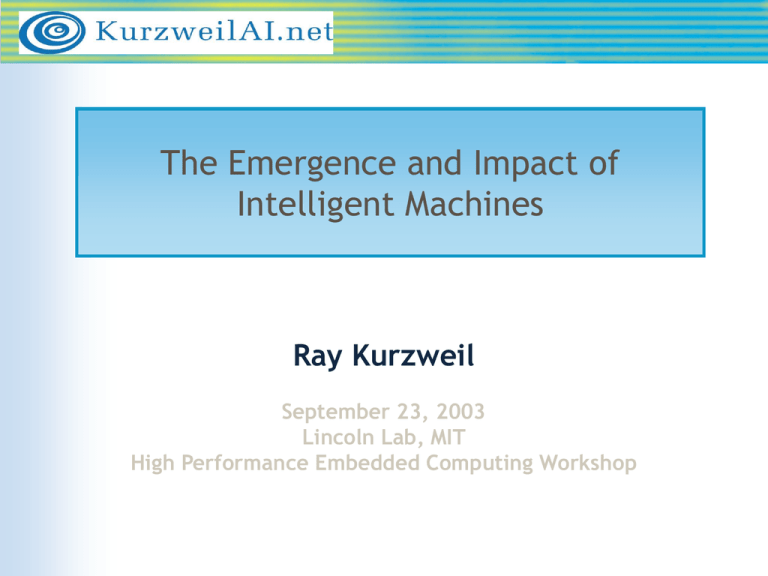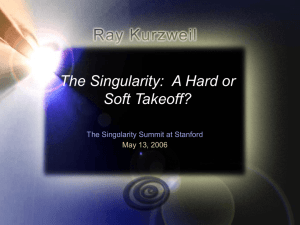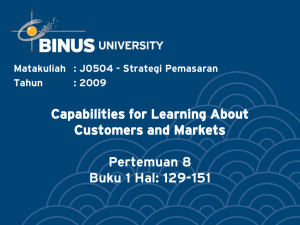The Emergence and Impact of Intelligent Machines Ray Kurzweil September 23, 2003
advertisement

The Emergence and Impact of Intelligent Machines Ray Kurzweil September 23, 2003 Lincoln Lab, MIT High Performance Embedded Computing Workshop 2 3 4 5 Measure IBM 7094 Notebook Circa 2003 Year 1967 2003 Processor Speed (MIPS) 0.25 1,000 Main Memory (K Bytes) 144 256,000 Approximate Cost (2003 $) $2,000,000 $2,000 22 Doublings of Price-Performance in 36 years, doubling time: 19 months not including vastly greater RAM memory, disk storage, instruction set, etc. 6 7 8 9 10 11 12 13 14 15 16 17 18 19 20 21 22 23 24 25 26 Planetary Gear Copyright IMM and Xerox 27 Nanosystems bearing Copyright IMM and Xerox 28 Nanosystems smaller bearing Copyright Zyvex and Robert Freitas, designer 29 Respirocyte (an artificial red blood cell) Copyright Vik Olliver, vik@asi.org. 30 Respirocytes with Red Cells Copyright Vik Olliver, vik@asi.org. 31 Animation of a respirocyte releasing oxygen in a capillary Copyright 2001, Lawrence Fields, Jillian Rose, and Phlesch Bubble Productions. 32 High resolution still from the Animation of a respirocyte Copyright 2001, Lawrence Fields, Jillian Rose, and Phlesch Bubble Productions. 33 Microbivores II copyright Zyvex (Katherine Green) 34 35 36 37 38 39 Chart by Lloyd Watts 40 41 42 43 44 45 46 47 48 49 50 51 52 53 54 55 56 2010: Computers disappear Images written directly to our retinas Ubiquitous high bandwidth connection to the Internet at all times Electronics so tiny it’s embedded in the environment, our clothing, our eyeglasses Full immersion visual-auditory virtual reality Augmented real reality Interaction with virtual personalities as a primary interface 57 58 2029: An intimate merger $1,000 of computation = 1,000 times the human brain Reverse engineering of the human brain completed Computers pass the Turing test Nonbiological intelligence combines the subtlety and pattern recognition strength of human intelligence, with the speed, memory, and knowledge sharing of machine intelligence Nonbiological will continue to grow exponentially whereas biological intelligence is effectively fixed 59 Nanobots provide… Neural implants that are: Noninvasive, surgery-free Distributed to millions or billions of points in the brain Full-immersion virtual reality incorporating all of the senses You can be someone else “Experience Beamers” Expansion of human intelligence Multiply our 100 trillion connections many fold Intimate connection to diverse forms of nonbiological intelligence 60 The Challenge from Malthus: “Exponential trends eventually run out of resources” However… The resources needed for computation and communication are close to zero. Based on current understanding, there are sufficient resources on Earth for these trends to continue through the 21st Century: During which time nonbiological intelligence will become trillions of times more powerful than biological human intelligence Beyond that: yet lower thresholds, and expansion beyond Earth 61 Specific Paradigms do hit limits e.g., the flat IC’s of Moore’s Law will hit atomic limits within 15 years But then yield to other paradigms Moore’s Law is the fifth paradigm, not the first, to provide exponential growth for computing The Sixth paradigm will be 3D molecular computing The brain achieves its power because it computes in 3 dimensions despite an extremely bulky and slow information processing method (10 million times slower than today’s electronic circuits) Even Moore’s Law by itself will be sufficient to exceed human intelligence 62 The Challenge from Software: “We’re making exponential gains in hardware, but not software” However, we are making exponential gains in software, although the doubling time is indeed longer. 63 Software Price-Performance Has Also Improved at an Exponential Rate Example: Automatic Speech Recognition Software Price Vocabulary Size (# Words) Continuous Speech? User Training Required (Minutes) Accuracy 1985 1995 2000 $5,000 $500 $50 1,000 10,000 100,000 No No Yes 180 60 5 Poor Fair Good 64 There has been increased productivity from new languages, class libraries, software development tools: Doubling time is about 6 years Software complexity required to emulate the human brain is manageable: Compressed genome data that describes the human brain is 12 million bytes 6 billion bits X compression factor of 30 X 50% devoted to the brain 65 We have a specific game plan to reverse engineer the human brain Knowledge of the human brain at all levels is growing exponentially We will not program human-level intelligence link by link (e.g., the expert system “cyc”) But rather as an elaborate architecture of parallel self-organizing systems Educating such a system will be the hardest part of the software task 66 The Challenge from Ethics There is far less ethical resistance to the development of nonbiological intelligence (including intimate connection with our bodies and brains) than to biological tinkering In any event, ethical concerns end up as stones in a stream: the economic and moral imperatives are too strong There ultimately will be grave dangers, but the biological downsides are more apparent today 67 68 Graphs available at: KurzweilAI.net “The Law of Accelerating Returns” 69 Reference URLs: Kurzweil Technologies (links to all Kurzweil companies) www.KurzweilTech.com AARON and Cybernetic Poet: www.KurzweilCyberArt.com KAIN: www.KurzweilAI.net


